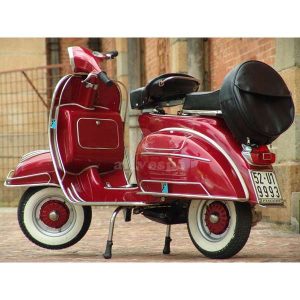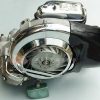Oh boy is this irritating… It’s definitely frustrating when you can’t get your scooter started. The first thing to do is to narrow down the problem:
You first need to narrow down the problem. In order for the scooter to start, it really only needs 3 things:
- Spark, at the correct time
- A proper fuel/air mixture and exhaust flow
- Sufficient engine compression
Sounds easy, right?
Compression check. If you just acquired the scooter, you should first do a full inspection before you try to get it running. Please see this page on restoration. If this is the case, I’d do a compression check first because it’s easy. First check the quantity and condition of the engine oil. Add oil as necessary. I wouldn’t change it unless it’s terribly dirty. The engine could be bad so you’d waste the oil change. Hook up or purchase a good battery. Leave out the spark plug and crank the scooter for ~5 seconds. This helps to circulate the oil. Let it set for ~15 seconds and do it again. It’s not a good idea to continuously crank the starter because it can overheat and wear prematurely. Most scooters need a minimum of 100 psi in compression to run start and properly. Compression should be checked when the engine is warm, but that’s kind of hard to do if the scooter is not running. So just hook up a compression gauge and open up the throttle all the way. Crank the scooter until the needle on the compression gague stops moving. This should take no more than 5 seconds. Very roughly, 100-125 psi is good, 125-150 psi is very good, and 150+ psi is great. If you don’t have this level of compression then you have bad valves and/or bad piston rings. If you want, you can add a teaspoon or so of oil to the engine through the spark plug hole. Then try the compression test again. If compression is higher, then it’s likely you have bad rings. The oil will seal the rings and give you better compression. If compression is the same, then you have bad/misadjusted valves.
Got spark? First check for spark. There are a few ways to do this. The easiest way is to remove the spark plug and put it back in the spark plug cap. Then ground it to the engine – you should be able to lay it against a non-painted portion of the engine. Make sure there is good metal-to-metal contact. In a semi darkened area, attempt to start the scooter. You should see a definite spark at the tip of the spark plug. It’s hard to see in direct light. If the color of the spark is blue, that means it’s a strong spark. A white color is less strong, and a yellow color is weak.  Most scooter starting systems are a bit weak (compared to cars). Even a yellow spark should start your scooter just fine. Next, the spark must occur at the right time. Just about all scooters made since around 1980 have electonic ignition. These systems rarely can be set. This is good news. After working on maybe 50 scooters, I’ve never seen one go out of time. Scooters with points are another matter. You’ll have to follow the timing procedure in the manual to get the timing correct. In general, the spark occurs just before the piston reaches the top of it’s stroke. There is a slight delay between the spark plug fire and the fuel-air mixture ignition. That’s why the spark occurs a little early. Most ignition systems have an advance unit build in, so that as the engine speeds up the time of the spark retards a little bit and helps the engine fire the mixture at the proper time.
Most scooter starting systems are a bit weak (compared to cars). Even a yellow spark should start your scooter just fine. Next, the spark must occur at the right time. Just about all scooters made since around 1980 have electonic ignition. These systems rarely can be set. This is good news. After working on maybe 50 scooters, I’ve never seen one go out of time. Scooters with points are another matter. You’ll have to follow the timing procedure in the manual to get the timing correct. In general, the spark occurs just before the piston reaches the top of it’s stroke. There is a slight delay between the spark plug fire and the fuel-air mixture ignition. That’s why the spark occurs a little early. Most ignition systems have an advance unit build in, so that as the engine speeds up the time of the spark retards a little bit and helps the engine fire the mixture at the proper time.
Starting fluid. Assuming sufficient compression, Squirt in a bit of starting fluid and see if she’ll fire. If so, great! That means that you have sufficient compression and the proper spark. You should get the scooter to run for a second or so on starting fluid. If so there’s a good chance you can get it running. One caution here – don’t run your engine for very long on starting fluid because it’s hard on the engine.
Fuel/air mixture. The last thing is the fuel/air mixture. You could be getting too much or too little of either. If the scooter has been sitting for a while, it’s likely the gas has evaporated and left a bunch of sludgy deposits. Ask the seller when it last ran. If it’s been more than ~3 months, you should clean out the fuel system and the carb. Disconnect the fuel line and drain the old gas. I’ve been able to burn old gas with no problem by using it in my truck. Add fresh fuel and make sure it flows smoothly through the petcock (on the bottom of the fuel tank). If the petcock is controlled by vacuum, you’ll have to draw a vacuum on the vacuum line in order for fuel to flow. The vacuum line will be the smaller line on the petcock. Do you get a good, steady flow of gas? If so, good. If not you will have to remove the petcock and clean it. The gas flow should stop when you release the vacuum.
Next, you’ll have to remove the carburetor and clean it. There are a low of tiny fuel and air passageways in the carb that must be clean it order for your scooter to run right. Carefully take the carb apart. This can be relative easy (on a 50cc scooter) or quite difficult (a Riva 180-200 has limited carb access and 8 separate hoses running to the carb). The carb has tiny passages that get gummed up. The scooter just will not run correctly if the carb is not completely clean, so take your time. I use a gallon container of carb dip (you can get a gallon at your local auto supply store for ~$10).
First remove all rubber and gaskets or they will be damaged. After a ~20 minute soaking I blow out the carb with compressed air. You have to get all the jets and the passageways clean. Be sure the jets are clear, especially the starter jet. Sometimes carb cleaner won’t clear out these tiny jets. Use a guitar/piano wire, a strand of copper electircal wire, or a tiny drill bit pin vise. Be sure not to increase the size of the hole in the starter jet or you’ll change the tuning. Carefully reassemble everything, checking for cracks in the rubber carb boots and the gaskets. Replace them if they are old and cracked. Be sure and remove all rubber and gasket material first or they could get ruined. Spray carb cleaner also works if you’re dilligent.
If you have an electric choke, check it to make sure it works. Check the resistance between the wires – you should see around 10 ohms or less. Measure the length of the choke assembly. Remove the choke from the carb and plug the wires into a 12V source for 15 minutes. The choke body should be warm. Measure the length again – it should increase by around 1/8″.
Next, consider whether your exhaust pipe is clogged. This is especially a problem with two stroke scooters. The unburned fuel/oil mixture builds up in the exhaust pipe along with carbon over time. If the exhaust pipe is clogged, your scooter will run terribly or not at all. It can be difficult to tell if the exhaust pipe is clogged. The easiest way to tell is to remove it and try to start the scooter. It will be a bit loud – two strokes will sound like a chain saw. If it runs, you know were the problem lies.
How was the old gas? Did the gasoline smell old? If the scooter has been sitting over a year or so, the gasoline will turn into a varnish-like stuff. Then you’ll have some serious cleaning to do. The gasoline will have evaporated for the most part, leaving a sludgy, molassas like substance in the gas tank, petcock, fuel lines, and the carb. All of these parts will have to be cleaned. This is especially a problem in the carburetor. Thoroughly flush out the gas tank and gas lines with new gas. I’ve had good luck using the old gas (in small quantities at a time) in my truck.
If the gas tank is not too rusted or dirty, you might be able to get away with just flushing it out. Pour in some fresh gas. But if you are uncertain how old the gas is (even if it smells ok), drain the gas tank, fuel lines, and carb float bowl and refill with fresh gas. I once worked on an Elite 80 with fresh-smelling gas. I could get it to run on starting fluid, but not on gas from the tank. I finally ended up draining all of the old gas and re-filling with fresh gas. The scooter started immediately and run great after that.
Remove the fuel and vacuum lines from the petcock to the carb. Place a suitable container under the fuel line and draw air on the vacuum line to the petcock (if so equipped) and see how well the gas flows. The flow has to be more than a trickle. It should be steady and fairly substantial. If you get this flow, then you’re ok. Run at least a pint of gas through to help flush the system. If you don’t get a flow then it’s likely your petcock is clogged. You have to remove it to disassemble and clean it. Carefully reinstall it on the gas tank or you could get a gas leak. Reassemble everything and try to start the scooter. It will take several seconds of cranking to get the gas to work its way from the gas tank to the carb. Hopefully it will start now! :>)
The big test Install a new spark plug, especially if the engine is a two stoke. Clean or replace the air filter as necessary. The carb, air cleaner, and exhaust pipe are all carefully tuned to work together. Most scooters absolutely WILL NOT run correctly if any of this stuff is changed in a haphazard manner!
Double check all connections, then crank for 10-15 seconds. Did it start? Do you hear any popping, like the engine is trying to run? Most scooters will not start if you apply throtte while cranking. Honda scooters tend to start easier if you apply throttle just as the engine catches. Most Yamaha scooters will not accept any throttle at all until they warm up a bit. If the scooter catches, but doesn’t start, let it rest ~15 seconds before trying again.



















